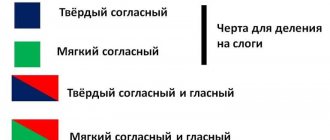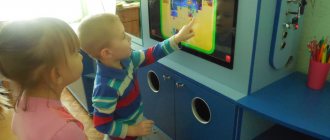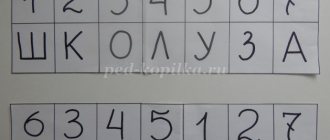Entertaining material
WHAT DOES A LETTER LOOK LIKE?
A bird flies over the gate, but does not sit on the gate. (E. Tarlapan)
The yogi lay down on his nails, Forgetting that he was a yogi. Yogi, anoint yourself with iodine, you will become a yogi again! (V. Lunin)
The poplar stands above the mountain. The bird flies to the poplar. (G. Vieru)
The letter Y is called “And short.” I'm like And in your notebook. So as not to confuse Y with I, write a tick at the top. (V. Stepanov)
Phonetic exercise.
How do they scream in fear? (Oh!)
Who's attentive?
Remember the words with y that you will encounter in the fairy tale.
What do you know about yoga?
“What do you know about yogis?” - that was the name of the book that Mouse the mouse found in the garden. On the cover there was a picture of a naked guy - a yogi, who, as if nothing had happened, was lying on nails sticking out of the board. In other pictures, the same yogi simply stood with his bare feet on hot coals or sat frozen in a block of ice. In addition, Mouse read that yogis can go without eating or drinking for months. - Need to try! — Mouse decided. “I can imagine what will happen when mom opens the refrigerator, and I’m sitting there frozen and smiling.” Or dad opens the stove, and I sit there on the coals and say: “What, I’ve never seen yoga, or what?” To begin with, he hammered nails into the board and just lay down on them, when he immediately jumped up and started yelling at the whole garden: “Oh-ee-ee!!!” He ran home, took out iodine and began to smear the nail scratches on himself. And iodine burns! Mouse smears, groans, and thinks: “I’ll throw this book to the cat.” Let him now be a yogi.” (G. Yudin)
Where is the sound? The teacher invites the children to determine the position [th] in the words: strong, hockey, puck, iodine, ruler.
Summary of a literacy lesson “The sound [Y] and the letter “Y”
Summary of a literacy lesson “The sound [Y] and the letter “Y”
Target
: To consolidate children’s knowledge about the sound and letter
J
Material:
demonstration material
,
workbooks part 2, a simple pencil, colored pens and pencils, tumblers, counting sticks, felt-tip pens for working at the board
I. Organizational moment
Educator:
Today we will get acquainted with the new sound “Y”.
The sound [Y] is indicated by the letter - and short (Y). —
What letter does it look like (I). This letter is very similar to the letter "I"
Educator;
The letter Y is called “And short”
“Y” is like “I” in a notebook.
So that Y is not confused with I
Write a tick at the top.
Educator;
The letter "Y" is lazy. It rarely occurs at the beginning of a word, and then only in foreign words iodine, yoga, yogurt
Educator;
Determine: vowel or consonant?
Place your fingers on the larynx and determine the voiced or unvoiced sound [Y'].
Tell me, what is the character of the sound [Y']?
Conclusion
: The sound [Y'] is consonant, sonorous, always soft.
II. Main part.
One child does a task at the blackboard.
Whoever has the sound Y in his name goes to the board.
Yes, this is our
Andrey
(Work in the notebook Elena Astafieva: We play, read, write. Workbook No. 2. Federal State Educational Standard).
1.Game exercise “Put the letter in her apartment”
Goals:
consolidate knowledge about the studied sounds and letters; learn to choose the right and left front house, count the floors in order, starting from the bottom; explain the choice of your decision based on knowledge about sound.
Educator:
Guys, look, in your notebook you have drawn a house for letters, the owner of this house is a tumbler.
Andrey
placed the letter
Y
on the first floor, under the letter L, in front of the letter R.
Educator:
Which tumbler do we choose?
Andrey
: green with a bell
Educator:
Why?
Andrey
:
because Y is a consonant, voiced, and can only be soft
Educator:
Now
Andrey,
find the sound Y in the words and write the letter Y. (the child writes the letter if he writes all the letters in short words)
1. We appreciate the words:
Parrot: Y-
consonant, voiced, soft, located at the end of the word, written in green
Iodine : Y-
consonant, voiced, soft, located at the beginning of the word, write in green
Mike : Y-
consonant, voiced, soft, located in the middle of a word, write in green
2. In empty cells, draw objects with the sound Y
Andrey:
Yogurt : Y-
consonant, voiced, soft, located at the beginning of the word, write in green
Tram: Y- consonant, voiced, soft, located at the end of the word, write in green
Nightingale: Y- consonant, voiced, soft, located at the end of the word, write in green
Educator:
What objects did Dasha and Zhenya draw?
Dasha: sparrow, yogurt, ant
Zhenya: Thumbelina, Aibolit, watering can
Educator:
well done guys, we did it all
2. Game exercise “Continue according to the pattern”
Goals:
consolidate knowledge about sounds and letters. Training a child's visual memory
3. Exercise “Continue the ornament”
Goal: continue according to the example; develop visual memory
4. Exercise “Finish the drawing”
Target:
develop hand motor skills
5. Game "Transport"
Goals.
Using the words:
transport, air, water, city
, we train the ability to perform sound-letter analysis and synthesis of words.
We develop the skill of dividing words into syllables. We consolidate knowledge on the topic “Transport”,
the ability to distinguish between types of transport (water, air, city, railway).
Progress of the game.
The adult offers to name and summarize in one word the objects presented in the picture
(transport).
The child performs a sound-letter analysis of the word
transport.
(The adult draws his attention to the difference in the pronunciation and spelling of the word: [transpart],
transport.)
The child names the letters missing in this word, writes them in (T, R, N, S, P, R, T) and generalizes (consonants ).
Assignment: remember the types of transport (air, water, city, railway).
The child analyzes the words written under the pictures and performs a task with them similar to the previous one;
fulfills the sound and syllabic schemes of the words water, air, urban.
The child indicates with arrows what type of transport each car belongs to.
An adult asks the question: “What type of transport was not mentioned in the game?” (Railway).
The child lists cars related to this type of transport.
6. Game “Draw it yourself” Goals.
We train the ability to write (copy) words.
We consolidate knowledge about the correct spelling of the word transport.
We develop the skill of sound-letter analysis and synthesis.
We test your knowledge on the topic “Transport”. Progress of the game.
When performing a sound-letter analysis of the unfinished word
transport,
the child writes in the missing vowels, commenting on the correct spelling of this word.
Then he analyzes the outline of the sentence that includes the word transport,
and determines how many more words need to be added to this sentence.
The adult explains that the word denoting the mode of transport is unfinished here. The child needs to enter (copy from the previous game “Transport”) the name of any type of transport. While completing the task, he remembers the rule: the first word in a sentence is written with a capital letter.
In conclusion, the child draws and names cars related to this type of transport.
7. Game "Tram" Goals.
We learn to divide words into syllables and determine the order of syllables in a word.
Using the example of the words dump truck, truck, tram,
we continue to develop the skill of sound-letter analysis and synthesis.
We consolidate the ability to differentiate types of transport (freight and passenger transport).
We develop visual attention, the ability to recognize objects by dotted patterns and independently complete such a pattern.
Progress of the game.
The adult explains that in the written words you need to place the syllables correctly - then you can read the names of various cars.
Having rearranged the syllables, the child reads and writes the words: dump truck, tram, truck.
It is proposed to determine which of the machines is redundant and why.
(The tram is superfluous, since it is a passenger transport, and the rest of the cars are freight.)
The child must find out which of the cars is drawn with dots
(tram).
The child completes the dotted drawing, colors it, signs the name, and completes the sound and syllable patterns of the word.
An adult should draw the child's attention to the correct pronunciation and spelling of the word tram. Summary of the lesson.
- So we got acquainted with the sound and letter Y.
- What can you say about this sound?
-Name words with the sound [Y].
- Guys, you tried your best today, listened carefully, answered well, everyone was great!
Finish the word.
The house on rails is right there. He will rush everyone away in five minutes. You sit down and don’t yawn. It’s leaving... (tram).
Guess what we sang? Kara... (wai).
Guess what they sang to us? Bye... (bye).
What month is it, guess? The month of May).
What's in the glass, guess? Sweet tea).
Vocabulary work.
The answer word must contain y. What healthy drink do you know? (Tea.) What is the name of a beautiful waterfowl? (Seagull.) What is the name of the room for storing gardening tools? (Barn.) A necessary accessory for playing hockey. (Washer.)
Letter
Transformations of words.
Add one letter at a time. 1. How to get words from -ayka and -eyka?
2. Change each word so that it contains y. Builder (construction); pour (watering can); hare (bunny); reader (read); winter (in winter).
Summary of a literacy lesson for children in the preparatory school group “Sound and letter Y”
Topic: Sound and letter “Y”
Correction and development tasks:
1. Teach children to listen carefully to the speech of adults and correctly understand lexical and grammatical constructions. the sound [Y] correctly . 3. Improve the skills of analytical and synthetic activities. 4. Continue to teach how to analyze a sentence and draw up its diagram. 5. Learn to transform words. 6. Improve the ability to determine the place of sound in a word. 7. Develop fine motor skills of the fingers.
Progress of the lesson.
Organizing time.
Speech therapist: Today in class we will get acquainted with another interesting sound and letter. Well, first let's play.
1. Didactic exercise “What is correct?”
Speech therapist. I name the proposal, and you listen carefully. If everything is said correctly, then do not raise anything, but if there is an error, a signal sign and we correct the sentence.
The cart is pulled by a horse. The cat caught the mouse. After winter came summer. The lantern is illuminated by the street. A pedestrian crosses the road.
2. Getting to know the sound [Y] .
Speech therapist. Guys, listen to the words and think how they are similar.
Sparrow, stream, burdock, nightingale.
Speech therapist: Who guessed how the words are similar? What is the last sound in these words? (sound [th].) Tell us what your tongue, lips, and teeth do when pronouncing this sound?
- Let's characterize this sound. What is he like? (consonant)
Why? (an obstacle appears in the mouth when pronouncing). You need to remember that this sound is always soft. How will we designate it? (green square).
3. Play “Show me a green square when you hear the sound [Y].”
Speech therapist: Show the square when you hear the sound [Y].
- [th], [a], [e], [th], etc. (from a series of sounds); - do, mo, ay, you, oh, hey, that, etc. (from a series of syllables); - T-shirt, house, sparrow, duck, may, tea, etc. (from a series of words).
4. Determining the place of sound in a word.
Speech therapist. There are pictures in front of you. Let's name them all.
- And now everyone will take only the picture whose name contains the sound [th]. - Tell me what you took. (Children take turns naming their picture.) - Mark on the clouds the place of the sound [Y] in your word. - Let's check what you did.
5. Introducing the letter Y.
Speech therapist. In writing, the sound [Y] is indicated by the letter ... (Y). (showing the printed letter Y).
- What elements does this letter consist of? - There is a piece of paper in front of you. Find it.
6. Drawing up proposals and diagrams for them.
Speech therapist: Listen to the words and make beautiful correct sentences from them.
Bunny, sit, bush, under.
- What kind of proposal will you get? (The bunny sits under a bush.) - How many words are there in it? (four). What's the first word? Second? Third? Fourth? - Let's use the stripes to make a diagram of this proposal.
Similarly, we analyze the following sentences with children:
Tram, go quickly. Seagull, sea, fly, over.
7. Transform words.
Speech therapist. Guys, read the word. (MIKES).
-Let’s remove the letter “Y” from the word. What word will it be? (MAKI). -Let's read another word. (JAYS). Remove the letter “Y”, what happens? (JUICES). Which letter did we remove? What sound does it represent?
8. Sound-letter analysis of words.
Speech therapist: Let's now take cards with letters and analyze the word MAY. How many sounds are there in this word? (three). What's the first sound? ([m]).
How do we designate it on the diagram? (blue square). Why? (He is a hard consonant). What's the second sound? ([A]). How do we designate it? (red square). Why? (He is a vowel). What's the next sound? ([Y]). How do we label it? (green square). Why? (it is a soft consonant).
- Now try to parse the word TEA yourself. — Let’s check what you got? (One child explains his designation).
9. Summary of the lesson.
Speech therapist. What sound did we learn about today in class? What sound is this? Why? What letter does it represent?
Svetlana Smirnova, teacher-speech therapist, MBDOU “Kindergarten No. 7 combined type”, Pikalevo
- Summary of a speech therapy lesson for children with OHP - Sound [Z], [Z] and the letter Z
- Summary of frontal speech therapy lesson [Sound and letter B]
- Speech therapy lesson notes [Sound and letter Ш]
- Summary of a lesson on teaching older preschoolers literacy “Journey to the city of Zvukograd”
- Summary of a lesson on teaching literacy and speech development [Man and electrical appliances]
( 11 liked, average score: 4.09 out of 5)
Loading...






